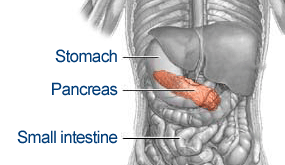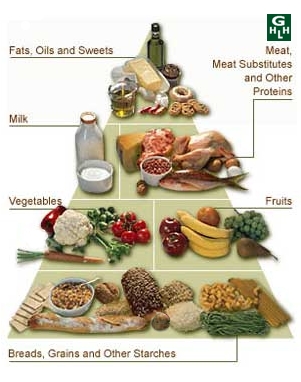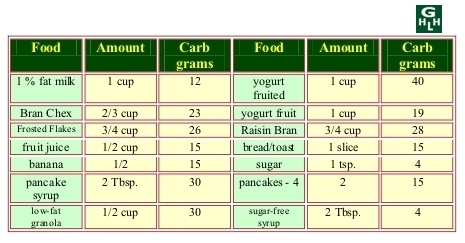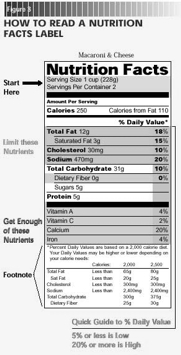Diabetic Diets Do Not Exist

The Truth about Diabetic Diets
In reality, Diabetes is not the "disease" at all.
It's actually a "symptom" - an outward "signal" - of a damaged pancreas that simply is too damaged to produce the insulin your body needs! So what is the pancreas, you might ask?
The pancreas is a long “gland”, right behind the stomach, that secretes insulin, glucagon, and somatostatin into the bloodstream.
Doctors tell you that when you have Diabetes, your pancreas "just doesn't" produce enough insulin - or no insulin at all.
That's been the explanation so far. Diabetes "just happens". But think about it: Does that really makes sense?
When millions of people around the world start experiencing the same health problems, something is seriously wrong. Something is unbalanced. And it's never an "accident".
What scientists have now discovered is... that the "Root Cause" of Diabetes is your pancreas. It starts as your pancreas becomes diseased when acids: sugars, carbohydrates, excess fats and uric acid (all very common in our modern diets) keep going from the stomach directly to the pancreas.
Because your pancreas is the next "link" in the digestion "chain", whatever you eat goes directly to this delicate organ... So instead of digesting food and producing insulin... it now becomes a “shock organ”.
Which means...
It Has to Absorb and Neutralize
All the Excess Acids
Our Modern Diets Dump Into it.
This is when you developed "Pre-Diabetes"... And if you don't stop the attacks on your pancreas, you develop Type 2 and eventually Type 1 Diabetes.
Our radical change in diet has actually transformed your pancreas into the “first line of defense” against acids, waste and toxins that all of us ingest... and keep ingesting... each and every day.
After doing careful research, I have come to the conclusion that diabetic diets do not really exist. You must follow a careful eating plan in order to control your blood glucose levels. Patients should ask their doctors for a referral to a dietitian as soon as possible after being diagnosed with diabetes.
The reason for this is that you will need to carefully set up an eating plan based on your level of exercise, medications, weight, and the foods that you love.
Planning Your Meals
1. Establish a routine for eating meals
2. Choose the healthiest foods in the right amounts at each meal
If you stick to your meal plan, and watch your serving sizes you'll find that you are consuming about the same amounts of carbohydrates and calories each day. However, if you do not follow a plan, it becomes more difficult to control blood glucose levels.
Another good reason to consult a dietitian is that they can help you tailor your eating plan based on your health goals. They are very good at planning diabetic diets that will help you with:
*Controlling overeating
*Making better food choices
*Losing weight
If you are on medication for your diabetes, you may need to follow a more deliberate plan, eating only a recommended number of servings from each food group every day.
Treatment Goals For The Diabetic
*Achieve near normal blood glucose levels.
*Protect the heart and aim for healthy lipid (cholesterol and Triglycerides) levels and control blood pressure.
*Achieve reasonable weight (defined as achievable and sustainable)
*Manage or prevent complications of diabetes. (heart and kidney disease)
*Promote overall health.
General Guidelines for Diabetes
Lose weight if body mass index is greater than 25-29


General Dietary Guidelines For Type 1 And Type 2 Diabetes
The Diabetic Diet Food pyramid divides foods into 6 groups. These groups on the pyramid vary in size. The largest group, the base of the pyramid, contains breads, cereals, grains, and starchy vegetables. these are the foods that you should eat the most of.
The smallest group fats, sweets, and alcohol is at the top of the pyramid, this tells you to eat very little of these.
The Diabetes Pyramid gives a range of servings. If you follow the minimum number of servings you will be consuming approximately 1600 calories per day. If you ate at the upper end of the range, it would be 2800 calories.
The Diabetes Food Pyramid groups the foods by their carbohydrate and protein content, instead of their classification as a food. For example you will find potatoes and the other starchy vegetables in with the grains, beans, and starchy vegetables group, instead of the vegetable group. Cheese is in the meat group instead of the dairy group because of its protein content. A serving of rice is 1/3 c in the diabetes pyramid, and 1/2 c in the Food Pyramid. The difference is to make all of the carbohydrates the same in each serving listed.

A Healthier Weight And Lifestyle
Diabetic Diets can be very helpful for people trying to lose weight. Reaching a sustainable weight is critical for people with diabetes. If you have type 2 diabetes losing just 10 or 20 pounds can improve your blood sugar levels so much that you can stop or reduce your medication.
If you smoke, you increase your risk of stroke or heart attack, you are also affecting your blood flow. This can cause problems in the legs and feet sometimes leading to amputation. Although alcohol in small amounts can be fit into your meal plan, if your blood sugar is under control, drinking alcohol on an empty stomach can cause low blood sugar, Alcohol can also contribute to the complications of diabetes, so consult with your doctor before imbibing.
For more Information on diabetes related health issues, click here.

Eat Healthy Carbohydrates
Focus on the healthiest carbohydrates because during digestion sugars(simple carbohydrates) and starches(complex carbohydrates) both break down into blood sugar. This is the most important part of treating the diabetic. . You should have 6-11 servings from the grains and starches group each day.
potatoes, yams, winter squash, corn, tortillas,
Whole grains, cereals, rice, pasta, bread
Legumes(beans, peas, and lentils)
Some Common Food Items And Their Carbohydrate Grams


Vegetables for Diabetic Diets,
All vegetables are naturally low in fat and are good choices to include in your meal plan and as snacks. This group includes carrots, spinach, Brussels sprouts, cabbage, cauliflower, and kale. Vegetables like potatoes corn peas, and Lima beans are included in the starch group.
A serving is:
1 cup raw
1/2 cup cooked
Fruits for Diabetic Diets,
The next layer is fruits, which also contain carbohydrates in the form of fructose. They also have plenty of vitamins, mineral, and fiber. This group includes apples, oranges, grapefruit, berries, cantaloupe, bananas, and grapes, plus many others. Choose 2-3 servings per day.
A serving is:
1/2 cup canned fruit
1 small fresh fruit ( banana, apple, orange 1/2 grapefruit)
1 cup melon or berries
1 1/4 cup strawberries
Milk
Milk products contain calcium, protein and vitamins. Choose non-fat dairy products for the great taste and nutrition without the fat. Choose 2-3 servings per day
A serving is:
1 cup non-fat milk
1 cup of yogurt
Free Foods for Diabetic Diets,
There are some foods that you can consume without counting.
Spread them out during the day, do not eat them in one sitting.
Bouillon or broth
Carbonated or mineral water
Club soda
Coffee or Tea (without cream or sugar)
Diet soft drinks
Sugar free tonic water
Sugar free hard candy
Sugar free jello
Sugar free gum
Sugar free jam or jelly
Sugar free syrup, 2 tsp
Remember, sugar is not the only carbohydrate that you need to control. All carbohydrates convert in the blood to glucose, so eating extra servings of pasta, rice, bread, and fruit will make your blood sugar rise. your meal plan is designed so that the carbohydrate s in your meal remain as consistent as possible.

Meats and Meat Substitutes for Diabetic Diets,
The meat group includes beef, poultry, fish, tofu, cheese, eggs, dried beans, cottage cheese, and peanut butter. Choose from lean meats, poultry and fish, Remove all visible fat from meat. Keep portions small, you only need 4-6 ounces per day.
A serving size is about the size of a deck of cards,
A serving is:
1/4 cup cottage cheese
1 egg
1 tbsp peanut butter
1/2 cup tofu
Limit Saturated And Trans Fats For Diabetic Diets,
Diabetic diets are a good way to improve heart health. Diabetes accelerates the development of clogged arteries, so it is a good idea to limit your fat intake in order to control your cholesterol levels. Heart healthy eating must become part of your meal plan, by making no more than 7% of your daily calories from saturated fat. The best way to to this is:
Limit solid fats(reduce the amount of butter, margarine, and shortening that you use)
Use low fat substitutions(low fat yogurt instead of butter on your baked potato)
Choose monounsaturated and Polyunsaturated fats.(olive oil and canola oil)
Monitoring
Managing your diabetic diet, is very important if you have diabetes, but your doctor will tell you that you also need to check your blood sugar levels several times a day. Blood sugar levels are usually more stable in people with type 2 diabetes, so they generally only have to test once or twice a day. But those with type 1 must test more often.
Pre-meal glucose levels of 90-130 mg/dl
Bedtime levels of 110-150 mg/dl
Different goals apply for those with serious medical conditions, young children, or pregnant women.

Other Factors Influencing Diet Maintenance
Food Labels:
It is important to always read the food label on your food products. Diabetic diets rely on careful calculation of calories, fats and carbohydrates. Current food labels show the number of calories from fat, the amount of nutrients that are potentially dangerous,(fat, cholesterol, sodium, sugars) as well as useful nutrients(fiber, carbohydrates, protein, vitamins. So be sure to read the labels carefully.
Keeping Your Eyes On The Prize
Enjoying your food plan is the best way to keep your blood sugar under control, and prevent diabetes complications. A diabetic diet can be easy to achieve and sustain. To improve variety, work in some of your favorite foods and ones you haven't tried yet. Get creative within the guidelines of your healthy eating plan. You will reap the benefits.
The information on this page is a guideline only, please consult you doctor before beginning any diet plan.
Back to Healthy Diet " pagefrom Diabetic Diets





